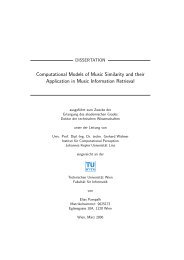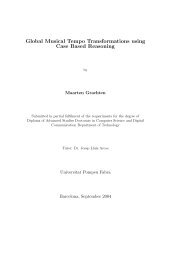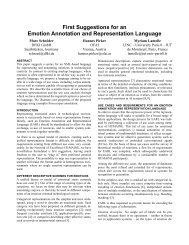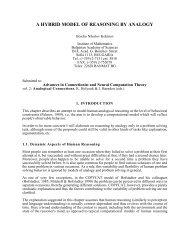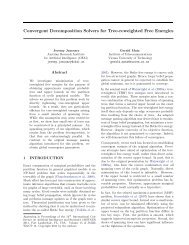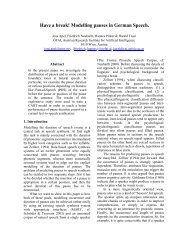A Simple and Effective Spectral Feature for Speech Detection ... - OFAI
A Simple and Effective Spectral Feature for Speech Detection ... - OFAI
A Simple and Effective Spectral Feature for Speech Detection ... - OFAI
You also want an ePaper? Increase the reach of your titles
YUMPU automatically turns print PDFs into web optimized ePapers that Google loves.
Proc. of the 15 th Int. Conference on Digital Audio Effects (DAFx-12), York, UK , September 17-21, 2012<br />
150<br />
FM4−h1.wav; lower 150 cent bins;4.8065s at second1209<br />
150<br />
FM4−h3.wav; lower 150 cent bins;4.8065s at second854<br />
100<br />
100<br />
50<br />
50<br />
20 40 60 80 100 120 140 160 180 200<br />
20 40 60 80 100 120 140 160 180 200<br />
Cross−correlation, offset=3, maxlag=3<br />
Cross−correlation, offset=3, maxlag=3<br />
2<br />
2<br />
0<br />
0<br />
−2<br />
−2<br />
20 40 60 80 100 120 140 160 180<br />
20 40 60 80 100 120 140 160 180<br />
0.01<br />
vector of max(result) over each column<br />
xcorr<br />
corr<br />
0.01<br />
vector of max(result) over each column<br />
xcorr<br />
corr<br />
0.005<br />
0.005<br />
0<br />
0 20 40 60 80 100 120 140 160 180 200<br />
0<br />
0 20 40 60 80 100 120 140 160 180 200<br />
x Result: (xcorr − corr), smoothed<br />
10−4<br />
8<br />
6<br />
4<br />
2<br />
0<br />
0 20 40 60 80 100 120 140 160 180 200<br />
(a) Music-<strong>Speech</strong> transition<br />
x Result: (xcorr − corr), smoothed<br />
10−4<br />
8<br />
6<br />
4<br />
2<br />
0<br />
0 20 40 60 80 100 120 140 160 180 200<br />
(b) Music <strong>and</strong> sung voice<br />
Figure 2: Comparison of the feature values <strong>for</strong> sections containing (a) music <strong>and</strong> then spoken speech <strong>and</strong> (b) music with singing voice<br />
(duration: approximately 5 seconds each). The top row shows the spectrograms (the lower 150 bins of the cent scale) of the two audio<br />
snippets. The second row shows the resulting cross-correlation values R(l) <strong>for</strong> offset = 3 <strong>and</strong> lag values l ∈ [−3, 3]. The third row<br />
compares the corresponding values r(= R(0)) (dashed line) <strong>and</strong> r xcorr = max l R(l) (solid line). The bottom row plots the correlation<br />
gain r xcorr − r, which is the basis <strong>for</strong> our proposed feature.<br />
Switzerl<strong>and</strong> (drsvirus, RSI Rete 2, RSR Couleur 3, Radio Central,<br />
Radio Chablais, RTR Rumantsch), which together represent all<br />
four official languages of Switzerl<strong>and</strong>: (Swiss) German, French,<br />
Italian <strong>and</strong> Rumantsch. The recordings were split into files with a<br />
duration of 30 minutes each, <strong>and</strong> manually annotated according to<br />
the two-class problem of ‘spoken speech’ vs. ‘other’, where ‘spoken<br />
speech’ refers to all segments which contain speech, even if<br />
mixed with other sounds or music (such as when a radio host introduces<br />
a song while it is already playing). 2 Note that this classi-<br />
2 Of course, the distinction between speech <strong>and</strong> non-speech is not always<br />
entirely clear, <strong>and</strong> neither are the exact boundaries where a speech<br />
signal ends or begins. (As as simple example, consider pauses in between<br />
sentences. In a sense, these are a natural part of the way we speak; but if<br />
such pauses grow longer, at some (rather arbitrary) point we will have to<br />
classify them as non-speech.) This observation, in fact, makes us slightly<br />
skeptical of some of the results in the literature, where recognition accuracies<br />
in speech/non-speech segmentation of 100% or almost 100% are<br />
reported. Our own preliminary experiments with multiple annotators per<br />
fication problem is considerably more difficult that distinguishing<br />
pure speech samples from pure music or noise samples.<br />
The training set consists of 21 hours of audio (42 half hour<br />
files, 7 files from each radio station) r<strong>and</strong>omly selected from the<br />
first two Swiss week batches. The validation set comprises 18 half<br />
hour files (3 per station). The r<strong>and</strong>om <strong>for</strong>est classifier is trained on<br />
the manually annotated ground truth; thresholds as well as postprocessing<br />
parameters are chosen empirically using the validation<br />
set.<br />
The audio files <strong>for</strong> the independent test set were recorded two<br />
weeks after training <strong>and</strong> validation data. The test set is made up<br />
of 31 hours of previously unseen broadcast material, split into 62<br />
files, distributed almost uni<strong>for</strong>mly over the 6 radio stations.<br />
Finally, to further test the robustness of the feature in relation<br />
to different languages <strong>and</strong> dialects, we recorded an additional 9<br />
audio file indicate an inter-annotator variability of up to 2%. Thus, not<br />
even the so-called ground truth is 100% reliable (nor can it be).<br />
DAFX-4




